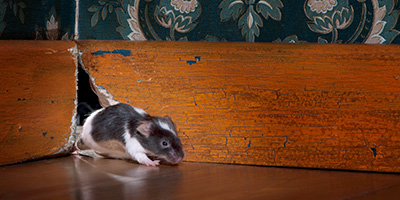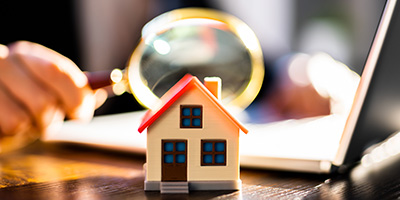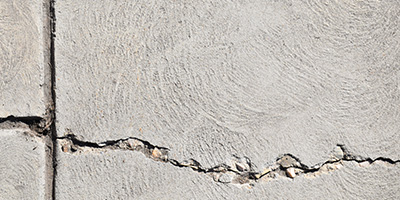How to Identify Subfloor Damage in Your Home

9 Signs of Subfloor Damage to Look Out For
Maybe you noticed a soft spot under the carpet. Or maybe your floorboards are squeaking a little louder than usual. Either way, you’re left wondering: "is it time to replace my subfloor?"
Subfloor damage is typically caused by overexposure to moisture. This could be from excessive humidity, a leak in your plumbing or a crack in your home’s exterior. While the thought of replacing it might give you a sinking feeling – literally – knowing when to replace subfloor from water damage allows you to head off more serious problems.
What Is Subfloor?
Subfloor is the solid material beneath your floor covering. It’s attached to your home’s floor joists and acts as a base for your finished flooring, such as carpet, hardwood, laminate or tile. Not only does it make installing new flooring easier, but it also makes your floors smooth to walk on.
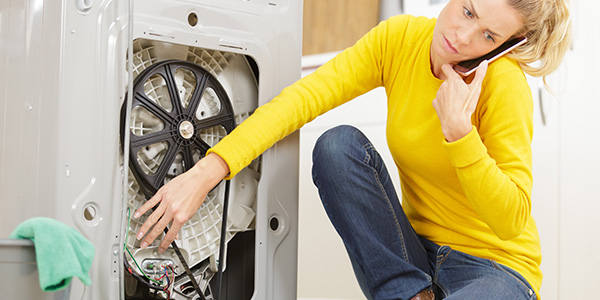
Top Causes of Subfloor Damage
Cracked flooring, faulty appliances, a loose toilet and a leaking ceiling are the most common causes of subfloor damage, as they expose your floor to moisture. If you find these problems in your home, make sure to address them sooner rather than later. You might be able to salvage your subfloor if you nip these issues in the bud.

“By far the most common cause of subfloor damage is moisture. Common sources are plumbing fixtures, especially toilets and tubs-with-showers, but also any areas with sinks or appliances that are likely to leak, including bathrooms, kitchens, and laundry rooms. Other less common causes are fire and impact.”
Kenton Shepard | Director of Green Building, InterNACHI
If your doors don’t hold up well during the cold and wet months, they can easily cause subfloor damage as well. “Exterior doors that are poorly installed can fail to protect subfloors from rain and snow, and it’s not unusual to find decay in these areas when inspecting crawlspaces and basements,” says Shepard. “Especially in warmer climates, crawlspaces that experience seasonal flooding can raise relative humidity to a level at which particle board can experience some deterioration.”
Can You Replace Subfloor by Yourself?
On average, replacing an entire subfloor in a 300-square-foot room can cost between $428 - $2,978. Note that this doesn’t account for the cost of replacing the finished flooring.
While you can replace your subfloor DIY-style, you should only do it if you have a decent amount of experience. We recommend hiring a professional for this project, as it ensures your floor remains level and can safely support your new appliances. Plus, a contractor will determine whether you need a moisture barrier to prevent water damage in the future.
How Much Does it Cost to Replace Subfloor?
The cost to replace subfloor depends on a number of factors including the quality, type and thickness of your subfloor material, as well as the additional work required (removing and disposing of the old materials, repairing joists or other flooring features, etc.).
Average Cost to Replace a Subfloor
Item | DIY | Professional |
|---|---|---|
Materials | $1.50 per square foot | $1.50 per square foot |
Labor | $0 | $25 to $30 per hour |
Professional subfloor replacements in kitchens and bathrooms may cost more than standard estimates. This is because the contractors may have to move appliances or fixtures to finish the installation.
Do You Need Subfloor?
Whether you need subfloor depends on the kind of flooring you have, which means knowing what above or below grade flooring is.
- What is above grade flooring? According to Hosking Hardwood, above grade is every floor located above the ground level of your home.
- What is below grade flooring? Every floor under the ground level of your home is considered below grade.
Above grade, hardwood, carpet, laminate and other floor coverings need a plywood or OSB panel subfloor, as they cannot be installed directly to floor joists. Below grade, a plywood or OSB subfloor is optional, depending on your choice of flooring. Floating laminate, engineered hardwood, tile and carpet can be installed directly on a concrete subfloor if the proper moisture barriers are in place.
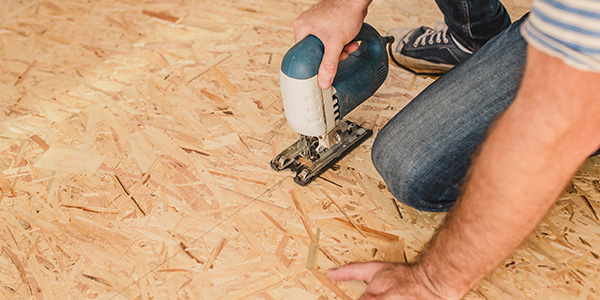
What Is Subfloor Made Of?
Typically, subfloor is made of plywood or oriented strand board (OSB) panels. In areas that are below grade, such as a basement, the concrete foundation is often considered the subfloor, though plywood and OSB panels can be installed over concrete using ground-level floor joists called sleepers.
How Thick Is Subfloor?
The thickness of your subfloor depends on the kind you have and the spacing of your floor joists. For safety reasons, OSB subfloor must be at least 23/32 inches thick while plywood subfloor must be ⅝ inches thick. But if your floor joists are especially far apart, your subfloor should be even thicker. For joists that are more than 16 inches apart, you’ll need at least ⅞ inches of plywood and 1 full inch of OSB for stability. Are your joists less than 16 inches away from each other? Just ½ inch of subfloor might do the trick.
How Long Does Subfloor Last?
Subfloor typically lasts 30 years or more, but if it is consistently exposed to moisture you may need to replace it sooner.
Does wet subfloor always need to be replaced?
Not necessarily. Damage caused by water can be reversed with help from professional tools, but it’s important to catch the signs of rot early to prevent it from spreading to the rest of your subflooring materials.

“A subfloor’s lifespan depends mostly on the materials used and the amount of moisture they’re exposed to. Adequately protected from moisture, most subfloor materials can be expected to last for the lifespan of the home.”
Kenton Shepard | Director of Green Building, InterNACHI
Rent a dumpster to get rid of your damaged subfloor.
9 Common Signs of Subfloor Damage
1. Your floor is uneven or sunken-in.
If your floor feels uneven under carpet, it could mean that the panels below have weakened. While replacing the entire subfloor may not be necessary, you will have to replace the damaged pieces to prevent the rot from spreading. Note — you’ll have to rip up your carpeting as well.
2. Your floorboards squeak — loudly.
Subfloors squeak when the nails connecting them to the joists are pulled loose. As you walk across the floor, the nails move in and out of the wooden joists, causing the awful, familiar sound of creaky floorboards. If you notice squeaking throughout the entire room, this could be a sign that the material has warped.
3. The room smells musty.
The smell of mold or mildew is a surefire sign of water damage under your floor, but the tricky part is finding where. If your carpet or wood floor smells musty, you almost certainly are dealing with a water damaged subfloor.
4. Your floors shift or bounce when you walk on them.
There’s nothing wrong with having a little spring in your step – unless that springy feeling comes from the floor. If your floors begin to feel spongy, springy or bouncy, or if you notice the floorboards around you shifting when you walk on them, it could mean that it’s time to replace your subfloor.
5. Your toilet is rocking or loose.
“A toilet moves because the subfloor has become so decayed that it no longer securely anchors the fasteners that hold it to the floor,” says Shepard. Often, the moisture damage is from a slow leak in your toilet’s pipes. Since it will only worsen with time, it’s important to get it fixed ASAP.
If this applies to you, consider removing your toilet and installing a new one.
6. Your flooring has cracked.
Because tile is inflexible, it requires a strong, rigid surface beneath it to prevent it from cracking. If you notice cracks in your tile floor, it may mean the subfloor isn't firm enough to hold it up and will need replacing. Keep in mind that when installing tile over plywood or OSB, there must be a cement backerboard between the tile and the panels.
7. Your hardwood floor is cupping.
While it could mean your home’s humidity is too high, hardwood floor cupping could also be a sign that water damage is warping the wood under your floor. If the center of your floorboards dip below the edges, your hardwood floor is probably cupping. But fear not – you can reverse this damage with the help of professional hardwood drying services, as long as the source of moisture has been addressed.
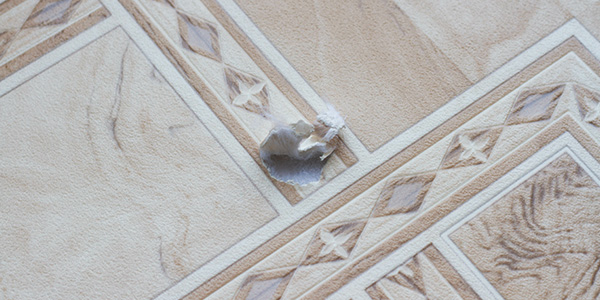
8. Your linoleum floor is bubbling up.
While bubbling linoleum isn’t always a cause for concern, it can be if it’s caused by moisture building up under your flooring. If there are irregularities throughout your linoleum floor, you may need to look a little harder to rule out water damage to your subfloor. To fix your bubbling linoleum floor, stick a needle in each bubble and press down to release the air. Then, lay a towel over the bubbles and iron over them to restore your floor to its flat finish.
9. Your ceiling is leaking.
To be clear, a leaking ceiling is not your subfloor’s fault. But it may be an indication that your home has a slow leak. Since plywood and OSB tend to absorb moisture, by the time water has leaked through the ceiling, it could mean the materials are completely soaked through. In addition to calling the plumber, you may want to call a flooring professional to check for subfloor damage.


